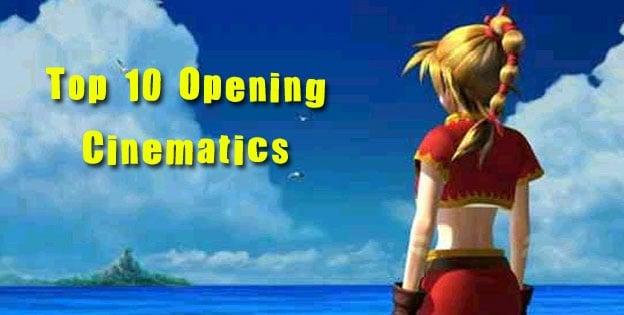Top 10 Opening Cinematics
Sometimes, we play a game simply because it’s good, and that’s terrific. I mean, that’s the heart of gaming, no? Enjoy yourself, find an experience that lets you unwind and have fun, or in some way makes your day a little brighter. Sometimes, though, our electronic entertainment finds ways to affect us that we didn’t expect, from deep and involved stories with intense characterization to even something as small as a well-crafted opening cinematic. Here, in my mind, are ten of the best introductions in gaming.
Metal Gear Solid 2: Sons of Liberty
Rain pours down on the George Washington Bridge as Solid Snake narrates, a lone figure in a poncho making his way down the walkway off to one side as cars rush down it in either direction, headlights blaring. The credits roll. The figure casts away a cigarette, then breaks into a run, casting away the poncho as he disappears to the sound of coursing electricity, his transparent silhouette leaping from the bridge. He hurtles down toward a tanker, which passes beneath the bridge, until a bungee cord appears on his back; as it goes taut, we see a flash of who it is: Solid Snake. He manages to land upon the tanker, electricity coursing from him in every direction as the stealth camo shuts down. So begins the iconic intro to Metal Gear Solid 2.
Soul Blade
Not all cinematic introductions tell stories, but Soul Blade’s is certainly one of the best. In fact, for me, the hallmark of a great introduction is that, regardless of how many times I’ve played the game before, I sit through it every time I start up the title. Soul Blade does that to me with its music, which has an epic rock beat and lyrics that kind of sort of explain the actual plot of the game. Also, the visuals were incredible at the time, and it does provide a pretty clear idea of who each of the fighters is.
BioShock
BioShock’s introduction, with its brief narration, cut to black over frantic audio, and subsequent fade to the game’s decaying logo, might not seem like anything special. At first. Play through the game to its major twist, though, and the sequence is burdened with new weight, from the words on the letter the player character reads to the implication of just what he does when the lights go out. It just shows the care and attention to detail that went into making the game that all of this ties together so neatly.
Final Fantasy VIII
Final Fantasy games have a distinctive flair for the cinematic, but none, in my mind, have matched the dynamic and even disturbing imagery of the battle between Seifer and Squall. Intercut with more peaceful imagery, the two duel in a rocky battleground, gunblades sparking and magic flying. That there is blood when Seifer cuts Squall’s face was, at the time, shocking to me. It was rare to see that in such a detailed cinematic at the time. Final Fantasy VII was the first in the series to use pre-rendered, high-quality CG cutscenes, but Final Fantasy VIII is where they really hit their stride.
Ninja Gaiden (NES)
Two ninja, one white and one orange, face one another in a field. We pan across them, cut to their faces, then their feet as they start moving, dashing rapidly toward one another. Their heads bob as they cover the distance, then feet kick off the ground, propelling them into the air. We cut wide as they arc toward each other, meeting at the peaks of their jumps and bringing their swords down. Both land and we see, from a viewpoint near the white ninja’s feet, the back of the orange ninja as he lands, then crumples to the ground.
And the music. My god, the music. It’s haunting, and followed by the reveal of both protagonist Ryu Hayabusa and the Dragon Sword, as well as the most iconic impetus behind a revenge mission ever undertaken: avenge one’s father.
- Page 1
- Page 2
